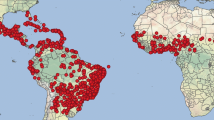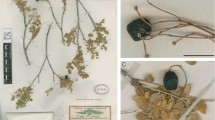Abstract
Aristolochia disticha was originally described based on a specimen collected by R. Spruce in Santarem (Pará, Brazil). Unfortunately, the specimen lacks flowers and fruits, although it has four slender, ramiflorous inflorescences that distinguish the species. Here we fully describe the species, based on the holotype and additional flowering and fruiting specimens that allow us to report a range expansion to the states of Acre, Amazonas, Bahia, Paraíba, and Rio Grande do Norte, Brazil, and also to Venezuela, French Guiana, Surinam, Peru, and Bolivia. Finally, we reduce the recently described A. setulosa to the synonymy of A. disticha.
Resumo
Aristolochia disticha foi originalmente descrita com base em um espécime coletado por R. Spruce em Santarém (Pará, Brasil). Infelizmente, a amostra carece de flores e frutos, embora tenha quatro inflorescências ramifloras delgadas que distingue a espécie. Aqui é fornecida a descrição completa da espécie, com base no holótipo e em amostras adicionais com flores e frutos, que nos permite registrar uma ampliação de ocorrência da espécie para os estados do Acre, Amazonas, Bahia, Paraíba e Rio Grande do Norte (Brasil), e para Venezuela, Guiana Francesa, Suriname, Peru e Bolívia. Finalmente, é aqui considerada como sinônimo de A. disticha, a recentemente descrita A. setulosa.
Similar content being viewed by others
Literature Cited
Araújo, A. A. M. & M. Alves. 2013. Aristolochia setulosa (Aristolochiaceae), a new species from northeastern Brazil. Brittonia 65: 301–304.
Freitas, J., E. J. Lírio & F. González. 2014. Aristolochia assisii, a new neotenic species of Aristolochiaceae from Espírito Santo and Bahia, Brazil. Phytotaxa 163(5): 262–268.
González, F. 1990. Aristolochiaceae. Flora de Colombia. Monografia No. 12. Universidad Nacional de Colombia, Instituto de Ciencias Naturales, Colombia, pp. 184.
———. 1991. Notes on the systematics of Aristolochia subsect. Hexandrae. Annals of the Missouri Botanical Garden 78: 497–503.
Hoehne, F. C. 1927. Monographia illustrada das Aristolochiaceas brasileiras. Mem. Inst. Oswaldo Cruz 20(1): 67–175, t. 16–103.
Hoehne, F. C. 1942. Aristolochiaceas. Flora Brasílica 15(2): 1–141, t. 1–123. Instituto de Botânica, São Paulo.
Masters, M. T. 1875. Aristolochiaceae. In: Martius, C.F.P., Eichler, A.G. & Urban, I. (eds.). Flora Brasiliensis. Lipsiae: Frid. Fleischer, 4(2): 77–114.
McNeill, J., Barrie, F. R., Buck, W. R. et al., (eds.) 2012. International Code of Nomenclature for algae, fundi, and plants (Melbourne Code), adopted by the Eighteenth International Botanical Congress Melbourne, Australia, July 2011 (electronic ed.). Bratislava: International Association for Plant Taxonomy.
Acknowledgments
The authors thank two anonymous reviewers for their comments and suggestions on the manuscript. FG thanks the KLARF Programme and the National University of Colombia for funding a post-doctoral fellowship at Kew in 2000.
Author information
Authors and Affiliations
Corresponding author
Rights and permissions
About this article
Cite this article
González, F., Freitas, J. & De Lírio, E.J. On the typification, identity, and synonomy of Aristolochia disticha Mast. (Aristolochiaceae). Brittonia 66, 337–339 (2014). https://doi.org/10.1007/s12228-014-9341-5
Published:
Issue Date:
DOI: https://doi.org/10.1007/s12228-014-9341-5




